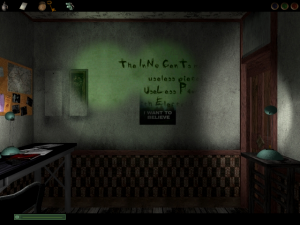Lights Out: The Twist
Things took a major turn in my latest session. I finally found a cave that had been mentioned once or twice in the lighthouse keepers’ notes, with the aid of a map found in a locked drawer in a locked room — see, this is how to do hard-to-notice hotspots right. Let us pass them by, then tell us there was something we missed, and then, if that’s not enough, give us more explicit help. And what was in the cave? A tunnel through time. It’s daytime on the other side, and more importantly, it’s the future, which is to say, the present. This is not something I was expecting, even with the anachronistic disc I had already found.
The lighthouse is a museum now, with a snack bar outside, some kind of exhibit about the island’s role in World War II, and bunch of plaques containing random facts about lighthouses and a truly excessive number of quotations from that Flannan Isle poem. Random objects that you were able to pick up and inspect back in the previous chapter are now behind glass and labeled. There are books in the gift shop about the vanished keepers — and one of the popular theories is that they were killed by the player character, Benjamin Parker. They don’t know that he was sent there to investigate disappearances that had not yet been made public; all they know is that he went out to the island for unknown reasons, and shortly afterward it was discovered that everyone was missing. Well, I had already learned that the man who sent him there was up to no good, and that Drake, the lighthouse keeper who went mad, was anticipating Parker’s arrival, but it’s unclear just what the scheme is. Maybe Drake knew Parker was coming because he had read the books too. He definitely knew about the tunnel.
Also at the site is Polly White, one of the ghost-hunters from the first game. Nigel doesn’t seem to be with her this time. You can find her camera, which has a few selfies on it. They’re rendered in CGI, rather than as a scanned photo of a live actor like Nigel’s selfies from before, so presumably we’re going to be meeting her. This makes it seem like we’re supposed to be adding “find the lady” to our list of goals, which fits with the rugged seagoing Edwardian bishounen thing that Parker’s got going on to form a potential time-crossed lovers scenario. For the moment, though, Polly is hiding from me, because she thinks I’m a ghost. Which, given her vocation, also means she’s hunting me, observing me from distance. If she still had her camera, she’d probably be taking photographs.
There’s one odd thing that the format does to that story. Your man-out-of-his-own-time is supposed to fumble with modern technology, be baffled and amazed by it as part of coming to terms with the unfamiliar (as a metaphor for the early stages of courtship). Parker, though, is under the control of the player. When you see a computer with a floppy disk drive, you know exactly what to do with it. The mysteries are elsewhere.
 Comments(0)
Comments(0)